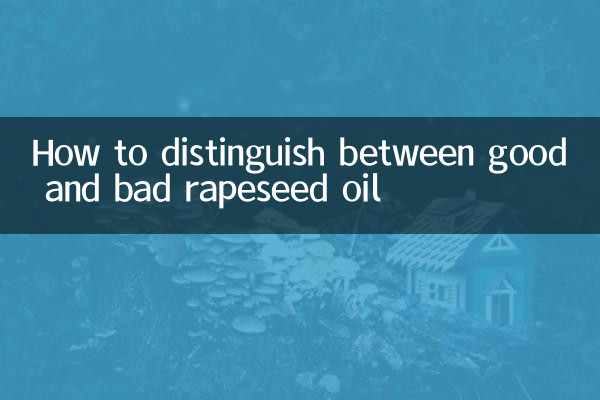How to distinguish between good and bad rapeseed oil
As a common edible oil in daily life, rapeseed oil is directly related to health. Recently, the topic of edible oil safety has continued to heat up on major social platforms and news media, especially how to distinguish the quality of rapeseed oil has become the focus of consumers' attention. This article will combine the popular discussions across the entire network for nearly 10 days to provide you with a structured discrimination guide.
1. Basic characteristics of rapeseed oil

Rapeseed oil is a vegetable oil extracted from rapeseed. It is rich in unsaturated fatty acids and vitamin E, but the quality on the market is uneven. Here is a comparison between high-quality rapeseed oil and inferior rapeseed oil:
| Comparison items | High-quality rapeseed oil | Low quality rapeseed oil |
|---|---|---|
| color | Golden Translucent | Dark brown or turbid |
| odor | No odor | Pungent or rancid |
| transparency | Clear and non-precipitated | There are suspended or precipitated |
| Taste | Lubricated without bitterness | Greasy or bitter |
2. How to distinguish the quality of rapeseed oil through the senses
1.Look at the color: High-quality rapeseed oil is golden or light yellow, with high transparency; inferior oil is dark or turbid, and may be mixed with other oils.
2.Smell the smell: Fresh rapeseed oil has a light fragrance, while inferior oils may have a sensation, sourness or other odor.
3.Taste the taste: Take a small amount of oil to taste. High-quality oil tastes refreshing, and inferior oil may have a bitter or greasy feeling.
4.Observe precipitation: Pour the oil into a transparent container and let it sit. High-quality oil has no precipitation. Poor oil may contain flocs or impurities.
3. Scientific testing indicators
In addition to sensory discernment, the quality of rapeseed oil can also be judged by the following scientific indicators:
| index | High-quality standards | Bad performance |
|---|---|---|
| Acid value | ≤1.0 mg/g | >1.0 mg/g |
| Peroxide value | ≤0.25 g/100g | >0.25 g/100g |
| Moisture and volatiles | ≤0.05% | >0.05% |
| Impurities | ≤0.05% | >0.05% |
4. Precautions for purchasing
1.Choose a regular channel: Priority is given to purchasing in large supermarkets or reputable e-commerce platforms, and avoid buying bulk oils without labels or unknown sources.
2.View packaging information: Pay attention to information such as production date, shelf life, QS mark, ingredient list, etc. to ensure that the product complies with national standards.
3.Pay attention to brand reputation: Refer to the evaluations of other consumers and choose brands with good reputation.
4.Price comparison: Products with too low prices may have quality problems, so don’t be greedy for cheapness.
5. Related topics in recent times
In the past 10 days, discussions on "safety of edible oil" have been very popular on platforms such as Weibo and Douyin. Among them, topics such as "How to identify adulterated edible oils" and "healthy benefits of rapeseed oil" have attracted widespread attention. Experts suggest that consumers should improve their identification capabilities and call for strengthening market supervision.
Through the above structured data and methods, you can easily distinguish the quality of rapeseed oil and ensure the health of your family. Remember, choosing high-quality cooking oil is the first step to eating a healthy diet!

check the details

check the details